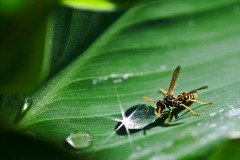How Do Paper Wasps Survive the Winter?
If you are living in the mid-Atlantic or Midwestern area, you have probably encountered a wasp or two flying around during winter and wondered how can such an insect survive the freezing weather. The wasp you encountered is most likely a paper wasp, a type of wasp that constructs water-resistant nests made from paper-like materials.
While practically all worker paper wasps die during the cold season, some female members of the colony can survive by seeking a protected area where they can live through the winter. The internal clock of these future wasp queens prompts them to check out different locations where they can hide and live as soon as the temperature starts dropping. They usually seek shelter inside chimneys, on top of door or window frames, or in between floor joists.
How Paper Wasps Invade Your Home
Apart from surviving all through the winter season, female paper wasps are also known for their ability to enter your home. As they investigate potential harborage areas, the female wasps enter through small cracks in the roofline. The moment they invade the home, their target is to find secluded and warm places such as gaps between the walls or in the attic.
Once they found the right spot, the female wasps would undergo a period of diapause or a physiologically enforced dormancy. This means that their body would not go through any development during this time. The female wasps' entry to the diapause stage is most likely the reason why you don't see any wasp flying around during the cold weather.
As soon as the weather becomes warmer, the wasps resume their activity. You may see them flying around in your home as they try looking for exit routes. These wasps are trying badly to go outside and begin the construction of their new nest.
If you see a bunch of these pesky wasps inside your home, it is best to call a professional wasp exterminator immediately. While wasps are generally sluggish at the beginning of spring, you should not take the chance and remove them yourself. Remember that wasps will not hesitate to attack and sting you when they feel threatened or disturbed. Wasps stings are painful and can cause serious redness and swelling and even allergic reactions in some cases.
How to Protect Your Home from Paper Wasps
If you want paper wasps to stay outside your home regardless of season, the best way would be to ensure that you have sealed all cracks or voids, so that wasps wouldn't have an opportunity to go inside. To do so, you may use steel wool or a waterproof filler and sealant, or a combination of both.
You should also pay close attention to areas where wasps would most likely inhabit such as door and window frames, attics, porch ceilings, soffits, and other similar places. It is also advisable that you hire a pest control company to "wasp-proof" or carry out preventive treatment in your home before the weather starts dropping and the wasps start moving in.


